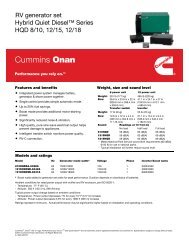Air Brake Manual
Air Brake Manual
Air Brake Manual
You also want an ePaper? Increase the reach of your titles
YUMPU automatically turns print PDFs into web optimized ePapers that Google loves.
Some systems have automatic slack adjusters that<br />
adjust automatically to compensate for brake lining<br />
wear, usually maintaining the correct clearance<br />
between the brake lining and drum. Automatic slack<br />
adjusters must be checked regularly to ensure that<br />
correct adjustment is being maintained. There are<br />
various makes and models of automatic slack<br />
adjusters in use. Primarily, they are either strokesensing<br />
or clearance-sensing. A stroke-sensing<br />
adjuster will adjust the slack when it senses the set<br />
stroke is exceeded. A clearance-sensing adjuster will<br />
adjust when the proper clearance between the brake<br />
drum and brake shoe is not maintained. Some<br />
automatic slack adjusters have the ability to back-off<br />
or increase the slack when it has over adjusted the<br />
brake. If a vehicle is equipped with automatic slack<br />
adjusters, it should not be taken for granted that the<br />
brakes will always be in adjustment. The system is not<br />
foolproof. A number of factors could result in the<br />
automatic slack adjuster not maintaining proper<br />
slack. There could be improper installation,<br />
inadequate maintenance, deformed brackets, worn<br />
cam bushings, bent push rods. Even poor visual<br />
inspection can result in problems unrelated to<br />
adjuster function. Automatic slack adjusters can<br />
malfunction and not keep the brake in adjustment,<br />
especially when it has been in service for a long<br />
period of time. The two most common problems are<br />
excessive premature wear and internal contamination.<br />
As an automatic slack adjuster ages in service,<br />
the components wear that sense when an adjustment<br />
is required. The result is more stroke is required for<br />
the lining to contact the brake drum, and if not<br />
checked the brake could be out of adjustment. If even<br />
a small amount of water is sucked into an automatic<br />
<strong>Brake</strong> Assembly<br />
slack adjuster mechanism it can cause corrosion or, in<br />
winter, it can freeze the internal sensing components<br />
and inhibit or prevent adjustment. Also, under certain<br />
conditions, an automatic slack adjuster that does not<br />
have the ability to back-off or increase slack, may over<br />
adjust a brake causing it to drag. For example this could<br />
take place when a tractor-trailer is negotiating a long,<br />
curving downgrade. The driver should “snub” the<br />
brakes, which is repeatedly applying the brakes<br />
moderately to maintain safe control of the vehicle.<br />
However it would not take long in this severe braking<br />
condition for one or more of the brake drums to over<br />
heat and expand. The over heating will physically<br />
increase the brake drums diameter, and in extreme and<br />
prolonged conditions will lead to longer push-rod<br />
strokes to achieve the braking force required. The<br />
automatic slack adjuster interprets this as a need for<br />
adjustment and will take up slack. When the brake<br />
drum cools down and returns to normal size the brakes<br />
are over adjusted and dragging. At that time the driver<br />
should stop and check the brakes for adjustment. A<br />
number of full brake applications per day may be<br />
required to keep the automatic brake adjusters in<br />
adjustment (see page 68 for more information).<br />
Because automatic slack adjusters are not foolproof, it<br />
is important the operator of a vehicle equipped with<br />
automatic slack adjusters be able to manually adjust<br />
them. For information on manually adjusting the<br />
automatic slack adjusters on your vehicle consult the<br />
manufacturer.<br />
Illustrated is a common type of brake assembly used on<br />
truck rear axles and trailer axles. A front axle assembly<br />
has the brake chamber and slack adjuster mounted on<br />
the backing-plate because of the steering action.<br />
<strong>Brake</strong> chamber<br />
Push rod, clevis and pin<br />
Slack adjuster<br />
S-cam<br />
<strong>Brake</strong> lining<br />
<strong>Brake</strong> drum<br />
19




